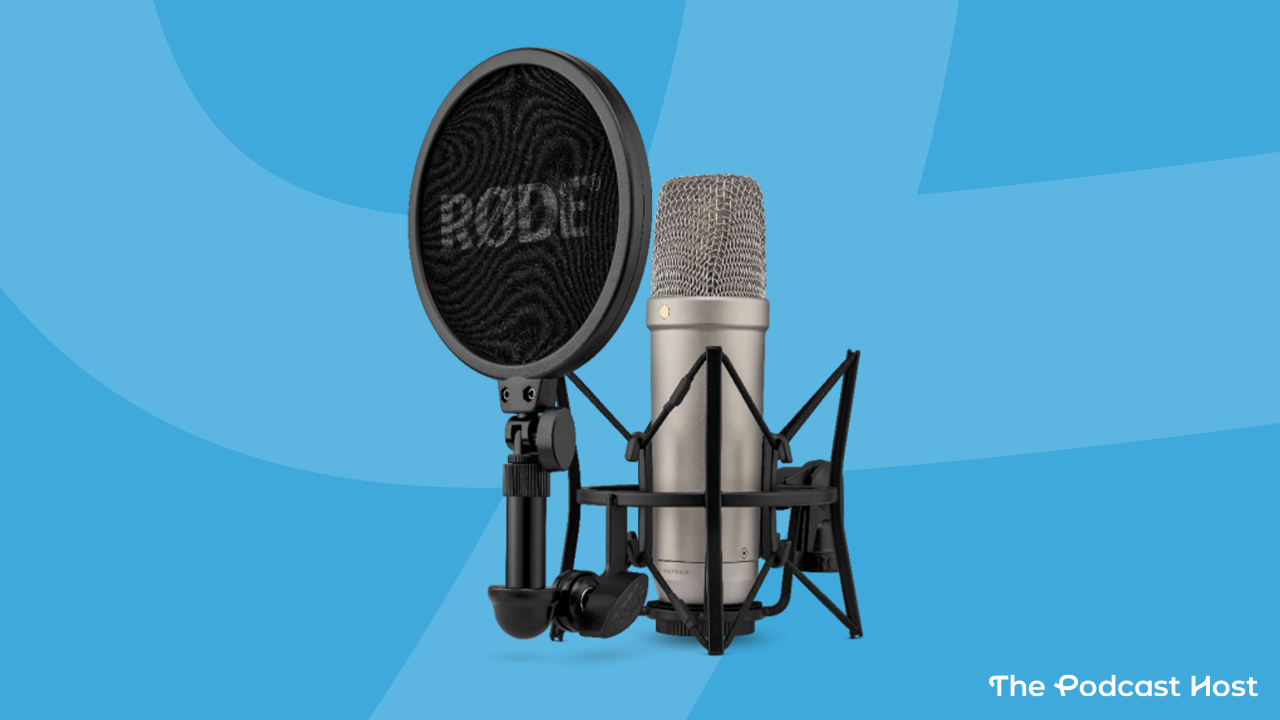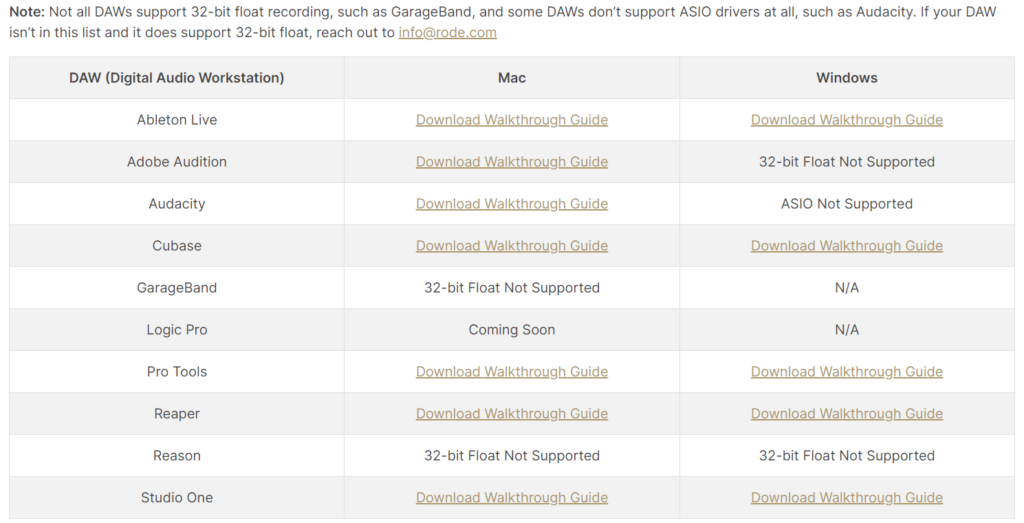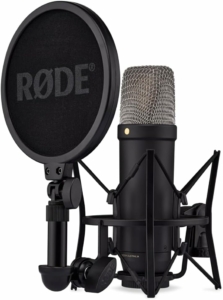Rode NT1 5th Gen Review: The World’s Quietest Mic?

The last time I reviewed a piece of Rode gear, the UPS driver (for reasons only known to himself) managed to throw it out the van window. How pleasing it was, then, to actually see him deliver the Rode NT1 5th Gen in a more conventional manner.
But effective delivery is only the first of many terrifying hurdles a mic must overcome to earn my approval. For some gear reviewers, this means a rigorous panel of sophisticated audio tests. For me, it’s opening the box. If you’ve ever seen me trying to open a box before, it’s a terrifying sight, and I’m guaranteed never to lose any less than a half pint of blood.
Once that torturous task is done and out of the way, my mic reviews follow a similar pattern. I plug them in, record a wee clip, listen back, and almost always think, “It sounds fine to me.”
Unfortunately, it’s hard to justify a wage by submitting such a review, so let’s take a closer look at the Rode NT1 5th Generation mic and help you decide if you’d like one of your own, shall we?

What is the Rode NT1 5th Gen?
Would you believe me if I told you it’s the 5th generation of Rode’s NT1 mic series? No, really! It’s great great great grandma, the original Rode NT1 was released way back in 1991.
Like its ancestors, the Rode NT1 5th Gen is a studio condenser mic. It works in both USB and XLR form, giving you plenty of setup options. It also offers a 32-bit float setting, which can eliminate troublesome gain levels. More on that shortly.
The World’s Quietest Mic?
The NT1 5th Gen has a self-noise of 4.5dB. “Self-noise” is the inherent noise of a piece of equipment in action, when there are no sound sources (voices, instruments, trees falling down in the forest). Self-noise often manifests as a low hum, hiss, or buzz.
Still, 4.5dB may mean nothing to you, so I’ll just say that I haven’t personally encountered a mic with a lower self-noise than the Rode NT1 5th Gen.
And even if you are on hand with a helpful “well, actually…” comment, anything technically quieter is unlikely to be audible to most human ears, so let’s just agree that this is a very quiet mic.

Remember!
Low self-noise alone doesn’t guarantee you pristine audio. Mic technique and recording environment are huge factors, too!
Rode NT1 5th Gen & 32-bit Float
If the NT1 5th Gen had a USP, it would be a toss-up between its low self-noise and its 32-bit float setting. We’ve covered the former, so what’s all this thirty two floaty stuff about?
You’ve probably heard of “gain” before, but if not, it’s essentially your gear’s input recording level. If you record too quietly, you need to amplify it later, which brings all the hiss/hum noise up with it. Record too loud, on the other hand, and your audio can clip and distort.
So here’s the tightrope we walk with audio – finding the Goldilocks zone of input recording levels. 32-bit float solves this problem, because you can record too loudly or too quietly, and your audio will still be fine.
Is Setting Gain Difficult?
32-bit floating is pretty cool, but I’m not convinced setting gain is a massive issue for most folks in the first place. If you’re thinking to yourself, “I’ve no idea how to set gain“, then it’s really no different from finding the right temperature of water in the shower. (if you’ve ever stayed in a Travel Lodge, then this might not be the most encouraging of analogies, sorry!).
You might run into gain-level trouble in a scenario where you recorded someone who likes to whisper one minute and then shout the next. Other solutions include telling that person to stop or not having them on your show in the first place. That said, this is common in the fiction podcast voice-acting world, which makes 32-bit float a great tool to have in your arsenal.
I also offered my “setting gain isn’t that hard” hot take to Colin, recently. He pushed back on that a bit, suggesting that it’s trickier if you’re recording video, especially if you’re unable to actively monitor your recordings. I get that, though the Rode Wireless Pro is arguably a better fit in this situation (I even promised to post him my set!).
So, 32-bit floating can be a nice safety net in some circumstances, and an absolute lifesaver in others. But, before you get too excited…
32-bit Float is USB-Only on the Rode NT1 5th Gen
The NT1 5th Gen can be used as an XLR or USB mic, but you can only access 32-bit float if you’re running it via the latter.
There are more hurdles, too. Whether you can activate this setting at all will depend on whether you’re on a Mac or a PC, and what DAW you’re using.

So there’s a chance you won’t be able to use the Rode NT1 5th Gen’s 32-bit float feature at all. If this is your main reason for buying one, do your due diligence first.
If you’re on Windows, there’s an ASIO driver to install to help you run and manage the mic. Personally, I’m a bit jaded with installing new gear software as it always seems to have a negative knock-on effect elsewhere in my setup. This is purely anecdotal, but I’m probably not the only one.
Still, we’re not at the end of the Rode (wey!) when it comes to cool features on the NT1 5th Gen…
Tolerance to Loud Sounds
Similar to its 32-bit float capabilities, the Rode NT1 5th Gen is unphased by extremely loud sound sources. Again, I’ll throw some seemingly random numbers and letters at you (142dB SPL) and tell you that this is great.
SPL stands for Sound Pressure Level, and a max of 142dB means you’re free to record on runways, at fireworks displays, and in close proximity to my daughter singing. Your eardrums might bleed, but your microphone won’t!
The Rode NT1 5th Gen as a USB Mic
As we’ve learned, using the mic as a USB can give you access to the 32-bit float setting, in certain setups.
You can also connect up to eight Rode NT1 5th Gens to your Mac via the Audio MIDI setup, or connect a bunch of them to your PC using the ASIO driver or Rode Connect software.
What’s cool about the NT1 5th Gen in USB form is that it doesn’t work like any old USB mic; it has a built-in USB audio interface, so as far as your audio is concerned, it’s just like using it in XLR form via a separate audio interface.
That said, if you use the Rode NT1 5th Gen in USB, you’ll notice (or at least you would have if I hadn’t told you first) that the mic doesn’t have a headphone jack. This means you can’t monitor your audio directly. I plugged my headphones into the computer to do this and there was a very obvious (and off-putting) lag.
I’m sure some will claim that my computer is rubbish (I won’t argue), but this, too, is something to be aware of.
The Rode NT1 5th Gen as an XLR Mic
USB mics used to be considered the simple option, but I find it much easier to plug a mic into my audio interface via USB. The interface is already set up with its drivers installed, so this has ironically become more of a plug-and-play option than most USB mics.
The only other tiny wee thing to do here is to press a button. On your audio interface, mixer, or digital recorder, there’ll be a Phantom Power setting (usually marked 48v), which will provide power to your NT1 5th Gen. The same rules apply for any other condenser mic you use in XLR form.
Pricing
At the time of writing, you can buy the Rode NT1 5th Gen brand new on Amazon for $250 or £215. Our Amazon links here are affiliates, but that doesn’t prevent us from reviewing fairly. At least, until they drastically improve their commission rates.

How Does the Rode NT1 5th Gen Sound?
Good God, we’ve talked through all of this stuff, and I’ve not even given you a listen of the thing yet.
There’s a wee gold dot (I think this is real gold, so I’ll be wedging it out with a screwdriver and putting it on my ear or something) to indicate which area to talk into.
If you ever hear me going off-mic, rest assured that my jewellery is on point.
Anyway, “just shut up and record something” I hear you cry…
I recorded these via my Maono PS22 USB audio interface into Adobe Audition. I didn’t apply any post-processing, cleaning, EQ, etc, though I did normalise both to -19LUFs.
It’s a lovely-sounding mic (shame about the guy speaking into it, I know!), and it performed well even in the untreated environment. However, the fan noise from my computer was definitely audible in one sample. It managed to stay quiet in the USB use case test, though…
Setting Up & Accessories
Just a couple of other wee things to touch on before we wrap up this Rode NT1 5th Gen review!
Boom arm – you’ll need one. They don’t need to cost much, but don’t go super-budget or the weight of the mic will start to droop it.
Shock mount – you get the SM6 in the box; this attaches to your boom arm and works like a safe, cozy nest for your mic to roost in.
Pop filter – the in-the-box pop filter attaches nicely to the shock mount. I found the mic vulnerable to plosives, so I’d recommend using it, even if you’re a YOLOer.
Cables – there are two in the box, a lovely postbox red XLR, and a very ordinary-looking USB-C cable.
Rode NT1 5th Gen Review: Conclusion
As much as I joked about most mics sounding alright, I have wanted to review the Rode NT1 5th Gen for a while, so thank you, Rode, for helping make that happen. And thank you, UPS, for actually bothering to deliver it, this time.
I felt like I was being negative or critical during some of this review, but I’m genuinely impressed with the mic. Much of what I’ve said around the 32-bit float setting was intended as more of a heads-up than a critique. I also don’t think this alone is a reason to buy it. $250 isn’t an outrageous price, but you can quickly learn to set your gain for free.
I see this being a nice option for a podcaster who’s cut their teeth on a cheap but functional dynamic mic, and is starting to notice the high levels of hiss or hum underneath their vocals. In this scenario, treating yourself to a Rode NT1 5th Gen would give you maximum appreciation for how the mic performs and sounds.
It isn’t a first podcast mic, though, unless you’re lucky enough to be gifted one. Save yourself at least $150 and get something cheaper. The biggest hurdle in podcasting is consistency, so make sure you’re going to stick at it before you invest too heavily. Here’s our main podcast microphones roundup if you’d like to do more shopping around – you’ll find options there for every budget, need, and use case.
Our Rating: 4.3/5
- Sound Quality: 5/5
- Pricing: 4/5
- Ease of Use: 4/5
